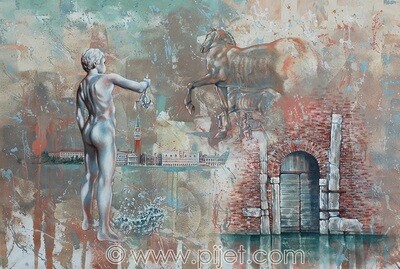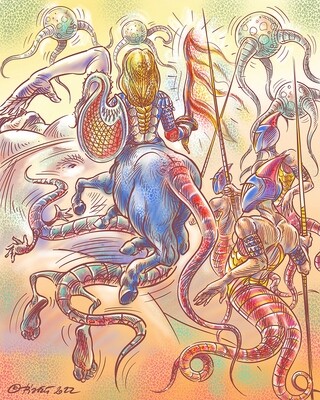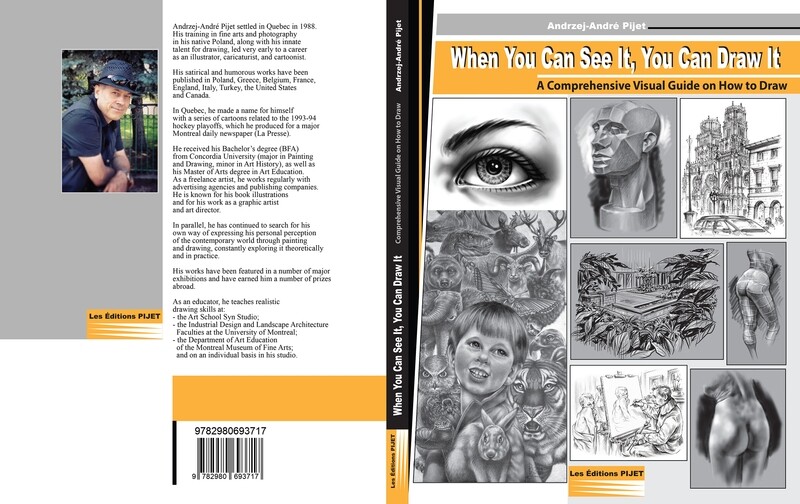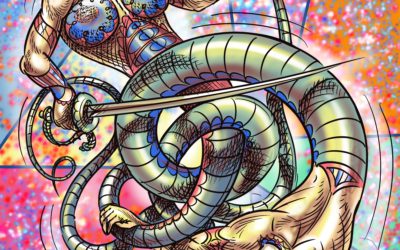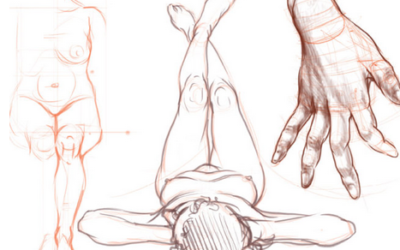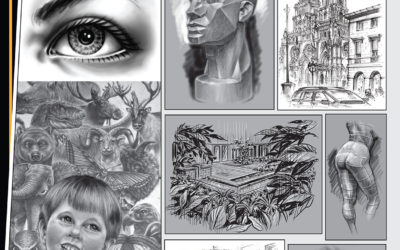Art School Confidential: Satirical Reflection on the Studio Art Education Methods in America.
Art School Confidential was at first a four-page black-and-white alternative comic created by Daniel Clowes. It originally appeared in issue number seven of Clowes’s comic book Eightball (November, 1991) and was later reprinted in the book collections Orgy Bound and Twentieth Century Eightball. A color edition of the comic was included in the published version of the screenplay for the film. Daniel Clowes also wrote the movie scenario, which was based partially on his earlier published comic story and had the same title. An interesting fact about the scenario is that Clowes created the four-page comic only because the printer’s deadline forced him to do so. He had left four pages of free space in his comic magazine Eightball, which he needed to fill up and send for print the next day. Clowes decided to draw on those four pages a critical review of his own experiences when he was studying art and design in the Pratt Institute in New York (BFA, 1984). The four pages of content were quite strong and critical not only of the school but also of the new artistic tendencies. Clowes even drew a copy of his diploma from the Pratt Institute in one of the comic scenes as a symbolic reflection of its inutility. Clowes and Zwigoff had previously worked together on another movie titled the Ghost Town (2001), for which Clowes also wrote the scenario, and where he touched lightly on a few aspects of art school practice.
The movie Art School Confidential reflects critically on the contemporary system of art education in America. The films seemingly corny narrative is in fact a lexicon of symbolic references to various contemporary art issues, which are exposed to the public through a group of different personages put in context of their actions. The Director, Terry Zwigoff, chose to approach art teaching in American art schools with a sarcastic eye and great wit. Zwigoff through a set of different characters refers symbolically to various aspects of contemporary art teaching practice. Furthermore, Zwigoff in his movie elaborates critically on the possibility of becoming an artist in the institutionalized jungle of questionable art theories and the philistinism of the Contemporary art market promoting, as Tom Wolf stated in his book The Painted World (1997): “…the triumph of mediocrity.” In the movie Jerome, the artist, needs to subject himself to the institutional aesthetic patterns in order to “succeed,” which the movie symbolically shows through his story and his character. It is yet another reference to the way artistic glory is usually created, which is to shock the spectator. It is exactly what Jerome does unconsciously, but he learns fast that as long as he will stay in prison he will make a fortune, he will be famous, and finally he will gain Audrey’s heart.
My choice of the movie was mostly motivated by its originality and an exceptional effort to expose the art school environment to the public in a critical funny humoristic way. This kind of movie is very rare and I personally do not know of any other, which might be compared with Art School Confidential and how the movie perfectly reflects the realities of American art teaching. Zwigoff recreated the contemporary art school atmosphere with an excellent wit and satire. Zwigoff’s film does not resemble any of Hollywood’s many creations, which most of the time promotes the teacher’s image as a hero. In this brilliant movie the real hero is Jerome, the talented utopic romantic student who has a dream to become a famous artist.
In reference to our readings and movies for the class discussions, the story in the movie Art School Confidential is told from the student’s perspective, which at the same time is also Clowes’s. In the Frederic Weiseman’s movies, High School (1968) and High School Two (1994), the visual and textual narrative is suggested to us through the director’s editing. Laurent Cantet’s film titled Entre les murs (2008) follows yet another pattern of arranged editing. The books of Deborah Meier The Power of Their Ideas (2002), Sylvia Ashton-Warner Teacher (1986), and Frank McCourt’s Teacher Man (2005) present various educational methods and approaches each of the authors has experienced as a teacher. In the movie Art School Confidential the art studio teachers, Professor Sandiford and Professor Okamura, are the examples of the “art educators” who are teaching not for the pleasure of teaching but for the necessity to be able to survive as artists. The only positive teacher character in this movie is the pure academic example of brilliant and witty Art History Professor played by Angelica Huston. In reference to Bulman’s article the movie promotes expressive individualism as something appropriate to the art school territory. It is very well expressed in the interview, which successful Strathmore Graduate Marvin Bushmiller had with students, during which he stressed the importance to transfer the artist’s personal achievement into a bank account as the way to artistic freedom.
The movie titled Art School Confidential (2006) tells the story of suburban boy, Jerome, who already as a child dreamed of becoming a famous artist. Jerome chose Pablo Picasso as his idol, because of Pablo’s multiple creativity and famous vitality. Jerome’s fixation on the subject of his dreams brings him finally to the Strathmore Institute where he hopes to get the necessary instructions in order to realize his desires of becoming an artist and gain the fame and success. Instead, Jerome is facing constant critiques from his peers and his instructor, professor Sandiford. His hopes that his talent for realistic drawing and painting will be recognized and appreciated, deceives him. He arrived at the institute armed with the ability to draw and paint realistically but nobody cares about his artistic perfection. Jerome is confused with the new aesthetics promoted by the school and tries to find his place in this entirely uncomfortable environment. He falls in love with a model named Audrey, whose picture he saw on the flyer’s page advertising the Strathmore Institute Art Department, and whose father is a known Pop Art artist. Jerome considers her as his main subject of artistic inspiration and is searching for the means to impress her, but unfortunately his efforts have no impact on her. She looks at Jerome’s depiction of her with minimal interest. Things get even more complicated for Jerome with the arrival in his class of a new student, Jonah, who is in fact an undercover agent and his presence in class is motivated only by the ongoing investigation and police hunt for the mysterious strangler who is operating on Strathmore campus territory. Jonah presents to the class his artwork, which is a simplistic representation of a car on an empty yellow space, which fascinates everyone except Jerome. Professor Sandiford and rest of the class are stunned by the childish perception of the car and to Jonah’s total surprise perceive it as an aesthetic novelty. Furthermore, Audrey is also fascinated by Jonah’s artwork and becomes his girlfriend, not knowing that Jonah is actually a married man. Jonah’s case is very symbolic in many ways, but the most interesting is the fact that after so many good comments about his paintings he actually begins to believe that his artwork is of great value and decides to take his art student role seriously almost forgetting the reason for which he came to the art school. Jerome is trying to paint in a similar way with a hope that his efforts will be recognized. Instead he is even more ridiculed by professor Sandiford and the class. Meanwhile Jerome’s friend and the spiritual guide on campus, Brado, introduces him to one of Strathmore graduates Jimmy, an alcoholic artist, who is actually the strangler hunted by police. Jimmy is using his victims’ skin, blood, and various personal objects for the composition of his paintings, which on one occasion he showed to Jerome. The enormous desire to win back Audrey’s heart and proof of his creative superiority over Jonah, he decides to commit a forgery and asks Jimmy to sell him his artwork. Jimmy refused, but Jerome takes advantage of Jimmy’s momentary indifference and takes all his paintings leaving by accident his not completely extinguish cigarette, which falls on the floor causing the entire building to burn completely. Jerome unconscious of his responsibility for Jimmy’s death uses his artwork as his own on the final school’s exhibit. However, the reaction to his new artwork is not what he expected it to be. It brings only the attention of the police to it. Jerome disappointed went to the roof of the school building with the intention to commit suicide where finally he is apprehended by police and arrested for being the Strathmore strangler. Jerome finally gets what he dreamt about, fame, money, and Audrey by pretending to be who he is not.
The movie, besides the main plot, has few very important scenes with educational values. First is the interview with Strathmore Graduate Marvin Bushmiller with the school students. Bushmiller’s character represents Clowes’s personification. Through his mouth Clowes expresses his anger against the faculty staff and ridicules the school’s credibility in teaching art. The freedom he gained as a practicing artist has nothing to do with the education he got in the art school. According to Bushmiller alias Clowes: “In order to be a great artist you simply have to be a great artist, there is nothing to learn, so you all wasting your time, go home.” (Art School Confidential, 2006). Jimmy is the opposite character to the successful and arrogant Bushmiller. He is also a Strathmore Graduate but also a rebel who refuses to subject his creativity to the institutionalized system of rules found in galleries and museums. He educates Jerome about art by sharing with him his artistic philosophies, “The real artist lives only for the narcotic moment of creative bless.” and “You cannot do anything good unless you stop carrying about if you live or die.” Two other important scenes are the two class critiques. Clowes in his scenario makes references to various art theories and movements as for example: feminism, queer, conceptualism, and relational aesthetics by assigning to each of them different characters expressing the appropriate concerns of each group. Furthermore, the movie refers also to the very common practice of the over intellectualization of artistic performances and theories. In one scene, Jerome visits professor Sandiford in his house, and during their conversation his teacher announces to him proudly that he paints simple triangles for over twenty-five years. It is the intentional parody of the Modernist remains in the art education system of contemporary art practice. The movie exposes clearly one dilemma, can art be taught and if so what should we teach our students to help them to find their own way in this exhausting and difficult process of becoming successful artist?
The movie titled Art School Confidential (2006) exposes the viewer to the abyss of contemporary studio art education practices, which is so rarely explored in cinema, especially today. The satirical regard on the system of contemporary art education is projected in the movie through a group of specific characters where each of them represents various issues connected to the process of learning “how to” in art. The movie portrays satirically the general misconception, which most talented novices have, about the way in which the art studio education system operates. It should be shown to anyone aspiring to become another “Picasso” of their times. The movie dramatic content reflects yet another portrait of a teacher’s responsibility in shaping the creative minds of students’ artistic sensibilities by imposing on them a set of rules and values concerning contemporary aesthetics. The movie explores also two different sources of knowledge, the one that he/she must obtain during their studies in the school environment and another from the outside world of real artistic practice. The question emerges which one is the most effective or destructive to the fragile and sensitive intellectuality of an aspiring young artist? The movie strictly comments about the character in regard to the contemporary system of studio art education practice and does not offer any clear solution to the way art should be taught in educational institutions, but it does make us think about the dark realities of the artistic market to which any aspiring young artist will be exposed after his/her graduation. Furthermore, the movie by its satirical content provokes more questions than it can answer. However, its humoristic regard on the process of learning in art schools could be a guiding reference to anyone dreaming of exploring the horizons of artistic endeavors. The movie inspires very interesting reflections. Why do so many young people want to become artists? It is understandable when looking at those with some technical predispositions and potential talent, but what about those who think that putting three different colors on canvas or a drop of red paint on a chair will make them great artists? Attending art school is kind of cool and it does not matter what one does it is still going to be considered by the contemporary system of art education as an artistic achievement. There is definitely a serious problem out there and as long as basically everyone and everything might be considered as art and artistic performance the question of what is art and what it is not will not be answered. Collingwood in his book titled, The Principles of Art (1958, p. 43) states: “Originality in art, meaning luck of resemblance to anything that has been done before, is sometimes nowadays regarded as an artistic merit.” In consequence anyone can be an artist, and it is what happens in art schools and what the movie Art School Confidential makes fun of. During my art school studies my professor told us that only one in sixty students would make it in the world of art. In the movie professor Sandiford extended this prediction to one from one hundred. James Elkins, in his book titled, Why Art Cannot Be Taught? (2001, p. 67), estimates that only “One of a thousand art students, maybe five will make a living off their art, and perhaps one will be known outside her city.” In reference to the visual and textual materials we have discussed in class Art School Confidential illustrates different stereotypes of contemporary art teaching. The movie questions the process of art teaching. Should art be taught? Can art be taught and if so how and what should be taught? This question has no easy answer if at all there is one. Many academics were and still are occupied with this seemingly simple question. James Elkins consecrated all of a book Why Art Cannot Be Taught? (2001) to investigate the issue of art teaching and concludes that the art as it was taught before cannot be taught today for very simple reasons, the contemporary realities are different, mediums are not the same, and in result there is not the need to teach the traditional ways of conceiving an art piece. In reference to the physical fact of teaching art I found interesting one phrase written in his book conclusion: “Teaching in an art department or an art school is the most interesting activity that I know, because it is the furthest from anything that makes sense-short of psychosis.” (p. 190) In addition to it Elkins cites the historian Paul Kristeller’s statement concerning art teaching: “art teachers are involved in the curious endeavor to teach the unteachable.” (p. 104 ) I think the Art School Confidential (2006) movie gave us a taste of it. Eisner, in his book titled The Arts and the Creation of Mind (2002, p. 46) writes, “How shall we think about teaching art? More than a few think art cannot be taught, only ‘caught.’ Others believe that even if it could be taught, it should not be. To try to teach art is to risk stifling students’ creativity, blocking their imagination, thwarting their personal expression. In the arts, students’ need support, materials with which to work, and then they need to be left alone to explore on their own.” In the movie Art School Confidential nobody is teaching anyone. What is the role of an instructor in the art school? According to Eisner (2002, p. 33) it is: “The role of the teacher is that of attendant, guide, inspirer, psychic midwife.” We do not see this kind of attitude in the movie, but in the course visual materials and readings of all the teachers are mostly responsible and devoted professionals. Furthermore, regarding to Eisner’s statement: “…To try to teach art is to risk stifling students’ creativity, blocking their imagination, thwarting their personal expression…” (p. 46). The most recent studies conducted by a group of researchers Huntsinger, C. S., Jose, P. E., Krieg, D. B., & Luo, Z. (2011) on the cultural differences in Chinese American and European American children’s drawing skills over time, the experiment was conducted with two groups of forty children each. The results confirm that Chinese American children overcame European American children in drawing skills due to instruction from an early age. Furthermore, their studies did not confirm the conviction circulating in the American educational system that the children without any drawing technical instructions benefit from a higher level of creativity. In order to take a generalized position more similar studies needs to be done, but one may predict the outcome of such studies already.
Regarding the movies educational aspect in reference to the way how teachers are depicted in various materials we went through during the course there is one scene in the movie which shows professor Sandiford in a positive light. It is when Sandiford meets Jerome in his home. He encourages him to keep working and experiment as much as he can. It is the only positive gesture of the megalomaniac Sandiford as a teacher. It would be even better if he would encourage him to do what he does the best and be himself and eventually his artistic style will appear. In order to be a good artist one needs to see, read, think, and most of all draw and paint as much as possible. Many students lose a lot of time trying to be what they are not. In such cases the art teacher has a lot to do if he is the real teacher. Professor Okamura, the sculpture and ceramics teacher in the movie is a perfect example of the wrong reason to be an art teacher and it is underlined by his remark, “Another day, and another dollar.” It is a great statement, which confirms what Bushmiller said during his interview about the Strathmore faculty staff, “…the faculty is made up of old failures who teach only because they need the health insurance.” All the movies and literature discussed during the course we have seen and learnt about various educative ways of teaching. All the teachers represented different approaches, but all of them were somehow passionate about their teaching practice. In the movie Art School Confidential we do not see any passionate teachers. It is maybe because according to Clowes and Zwigoff the art schools do not have such educators and I think that this is the message, which the authors want to pass through the film story. This would be proof of Elkin’s point that art cannot be taught, not only because the times are different but in general meaning too, and Eisner’s (2002, p. 32) statement that “…the activity of self-expression cannot be taught.” In such a case the role of the art instructor is to facilitate the student’s artistic development by instructing them to various techniques of artistic creativity in order to help them to explore their talent accordingly to the methods they feel comfortable with. Assuming that this is our case, we would need to have in art schools real professionals who are passionate teachers with a desire to transfer the knowledge they have to the next generation of creative youth. Until then we can simply enjoy the movie.
Zwigoff, Terry (Director). (2006). Art School Confidential [Motion picture]. United Artistes.
The first screening of the movie took place during the Sundance Film Festival in January 23, 2006, but officially it was released in May 6, 2006.
Main characters in the movie are:
Max Minghella – Jerome
Sophia Myles – Audrey
John Malkovich – Professor Sandiford
Jim Broadbent – Jimmy
Joel David Moore – Bardo
Anjelica Huston – Art History Teacher
Matt Keeslar – Jonah
Jack Ong – Professor Okamura
Ethan Suplee – Vincent
Nick Swardson – Matthew
Adam Scott – Marvin Bushmiller
Scoot McNairy – Army-Jacket
Jeremy Guskin – Eno
Monica Ramnath – Flower
Isaac Laskin – Kiss-Ass
I had a chance to study art in two different systems of art education. The first was the Eastern one, which at that time was based mainly on strict academic values and rules of pure academic realism. The second was the Western one, which propagates the ideology of artistic freedom in theory and practice of art. In my opinion the ideal situation would be to combine both methods together to the great advantage of any aspiring art student. The movie reflects my own satirical perception of contemporary art studio practices, which I have tested on myself. It is interesting that the film had not too many good reviews. It may be because not many critics saw the symbolic references to art world issues in this movie. Reading some of the critic’s one has an impression that most critics took the story too literally while in reality the movie is filled with symbolic references just waiting to be discovered. According to the Metacritic website, which always choses thirty critics from major American publications, Roger Ebert, from the Chicago Sun-Times (2006), on a scale out of one hundred rated this movie as seventy-five points. Ebert is the only one who had a few wise words to say about this movie: “I am not suggesting the school’s faculty serves no purpose; indeed, as a teacher of film appreciation, I believe faculties in the arts are sainted. They must guide, advise, moderate, encourage, teach methods, provide a context, share secrets and declare an informed opinion on the worth of the work. They create a world within which such work is possible and valued. What they cannot do, I suspect, is teach a student how to be original and creative.” and “There is a moment in the film when the students are asked to create a self-portrait. Jerome’s work bears comparison with the Pre-Raphaelites. The student whose self-portrait is most highly praised has created an assemblage of lines and squiggles that “looks like a Cy Twombly,” someone says — in praise. I’m not saying a 19th century representational style is superior to Twombly, but I do believe that in a freshman class, the purpose of a self-portrait assignment is to draw something that looks like it might be you. Students have to learn to walk before they can crawl.” Thomson Desson, from The Washington Post gave it seventy points. Thomson also had a few interesting remarks: “Zwigoff and Clowes want to mock art academia’s familiar stereotypes.” and “Jerome (Max Minghella) is an idealistic student with dreams of making it in the art world. But he’s ground down into a cynic by the self-absorbed teachers, pretentious students and unctuous suck-ups he encounters in art school. More and more, the jaded wisdom of a burnt-out artiste (Jim Broadbent) — who issues drunken, graphic metaphors about what academia is really about — makes sense.” Ken Fox, from the TV Guide (2006), rated it fifty points. David Efelstein, from The New York Times (2006), rated the film only thirty points. In the total of thirty critics, only thirteen are positive, another thirteen are mixed, and four are negative. Most of the critics who wrote about Art School Confidential used mostly repetitive comments without trying to go deeper in meaning. It is an unfortunate fact and it looks like some critics write as much as some artists teach just to try to “survive.”
To conclude, the movie is a must to first year undergraduate art students and to anyone wishes to study art. Furthermore, it should be watched by art school faculty members, which could allow them to look critically at their own motives to teach. Furthermore, do they really teach and if so what and how do they teach? The movie is done as a comedy, but it could be looked at as a realistic drama, which unfortunately reflects perfectly the contemporary art world of today. In my understanding art is not about repetitive style but constant research of aesthetic dialogue, it is a spiritual visual journalism, a method of intellectual communication of ideas about the world surrounding us. So far, it was only Picasso who was a real researcher; he tried almost everything and succeeded all the time. Most artists’ skip the research process and keep doing the same things all their lives. It is probably for a simple reason, which is convenience. Why looking further when one thing works well. In the movie professor Sandiford paints triangles for twenty-five years. It is an interesting psychological case. In the movie it is symbolic, but I wonder how many Sundifords we have in the World of art today? It is my personal conclusion and it is based on my own experiences, which to some extend resembles Jerome’s with one exception, which is: I will never use somebody else’s artwork to exhibit as mine.
Bibligraphy
Bulman, Robert C. (2005). Hollywood Goes to High School. Cinema Schools and American Culture. New York: Worth Publishers.
Collingwood, R. G. (1938). The Principles of Art. Oxford, England: Oxford Univeristy Press.
Ebert, Roger (2006, May 12). Chicago Sun-Times. Retreived from
http://rogerebert.suntimes.com/apps/pbcs.dll/article?AID=/20060511/REVIEWS/60508003
Eisner, Fred W. Elliot (2002). The Arts and the Creation of Minds. New Haven, USA: Yale
University Press.
Elkins, James (2001). Why Art Cannot Be Taught. Illinois, USA: University of Illinois Press.
Huntsinger, C. S., Jose, P. E., Krieg, D. B., & Luo, Z. (2011). Cultural differences in Chinese American and European American children’s drawing skills over time. Early Childhood Research Quarterly, 26(1), 134-134-145. Retrieved from
http://search.proquest.com/docview/822506546?accountid=10246;
http://dx.doi.org/10.1016/j.ecresq.2010.04.002
Metacritic (2006). Retreived from
http://www.metacritic.com/movie/art-school-confidential/critic-reviews
Thomson, Desson (2006, May 12). Washington Post. Retrieved from
http://www.washingtonpost.com/gog/movies/art-school-confidential,1106286.html
Wolfe, Tom (1978). Le Mot peint. Paris, France: Gallimard.
Zwigoff, Terry (Director). (2006). Art School Confidential [Motion picture]. United Artistes.

